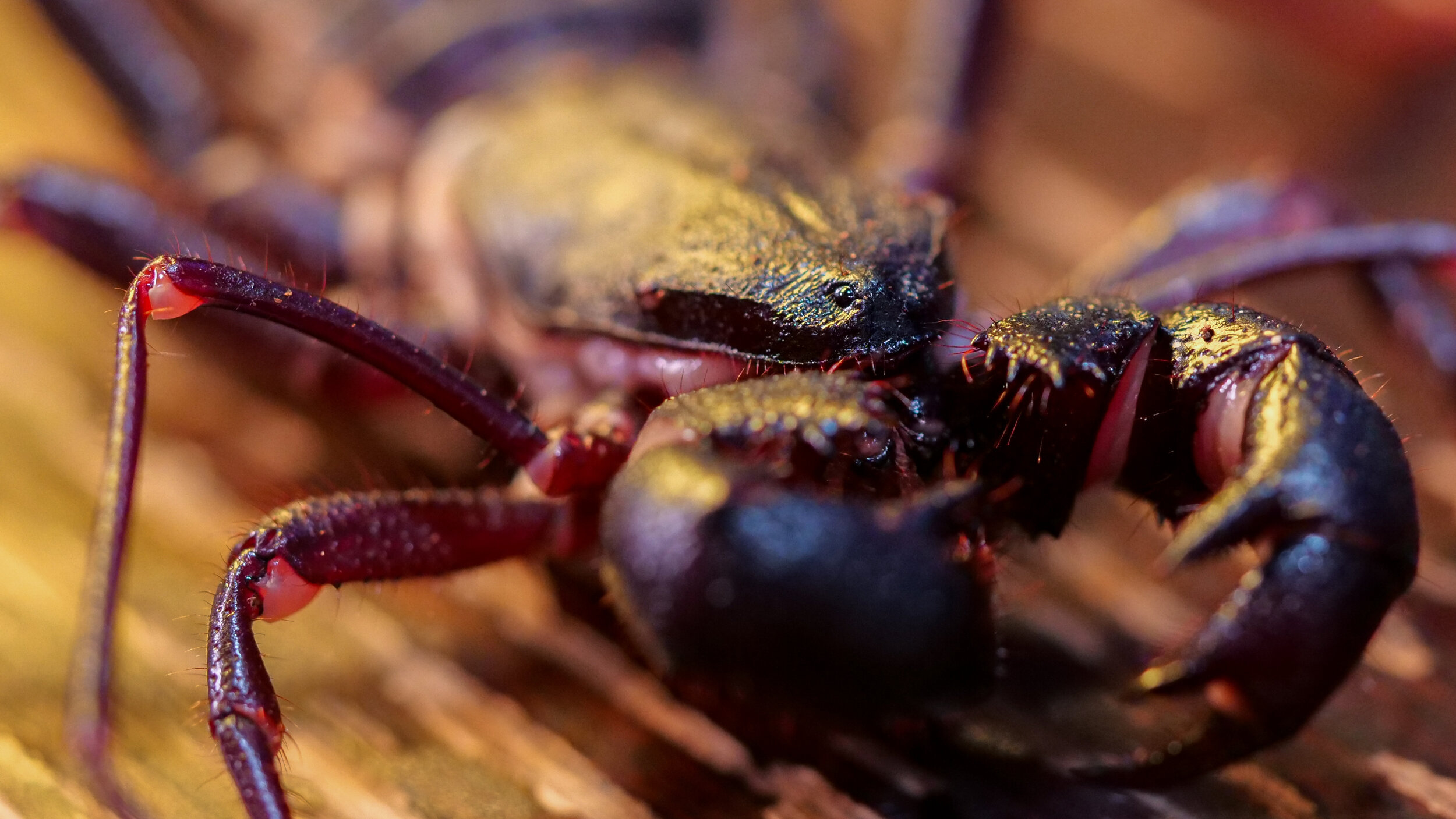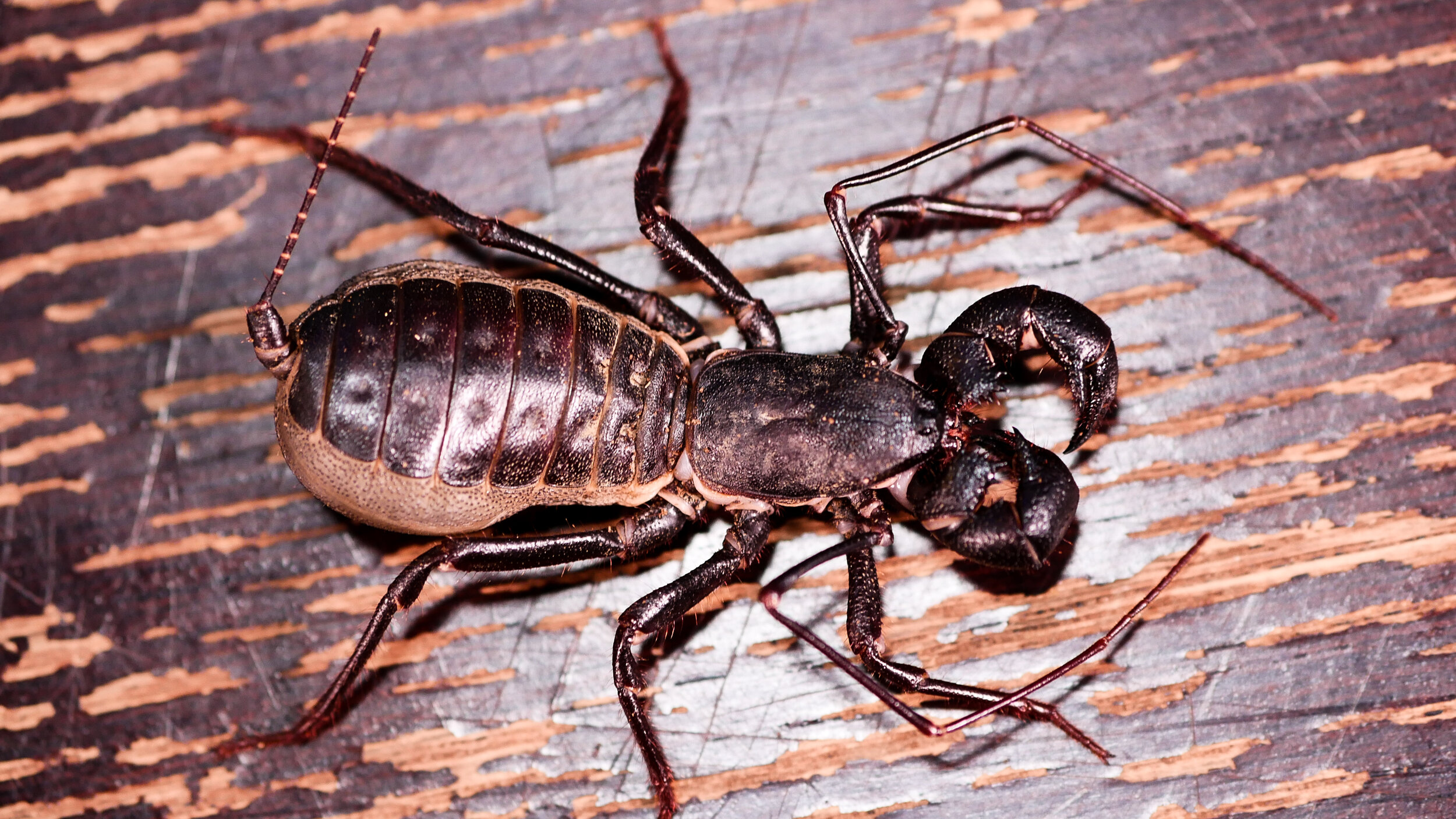Vinegaroon
Mastigoproctus giganteus
Care Sheet
Vinegaroon Care Video
Mastigoproctus giganteus Care Guide
The Giant Vinegaroon
Revision Date: March 2025
Introduction
Mastigoproctus giganteus, commonly known as the Giant Vinegaroon, Desert Whipscorpion, or Grampus, is one of the most unique arachnids in the hobby. Despite its intimidating appearance, it is completely harmless to humans, possessing no venom or stinger. Instead, it has a fascinating defense mechanism, releasing a mist of acetic acid (vinegar-like spray) from glands near the base of its tail to deter predators.
This species is a fossorial burrower that thrives in dry, arid environments and is endemic to the southern and southwestern United States. It is an excellent beginner species due to its simple husbandry requirements, long lifespan, and docile nature. Though nocturnal and secretive, the Giant Vinegaroon is a fascinating species to observe in captivity.
Quick Species Snapshot
Scientific Name: Mastigoproctus giganteus
Common Name: Giant Vinegaroon, Desert Whipscorpion, Grampus
Type: Fossorial (Burrowing)
Category: Non-venomous Arachnid
Endemic Location: Southern & Southwestern United States (Arizona, Texas, New Mexico, Florida)
Body Length: Up to 4” (10 cm)
Diagonal Leg Span (DLS): Up to 6” (15 cm)
Growth Rate: Medium
Life Expectancy:
Females: Up to 20 years
Males: 5–10 years
Recommended Experience Level: Beginner
Venom Potency: None (defensive spray contains acetic acid but is harmless to most humans)
Taxonomy & Research Update
Mastigoproctus giganteus belongs to the order Thelyphonida, which is closely related to spiders and scorpions. Although commonly referred to as a "whip scorpion," this species is not a true scorpion and lacks venom.
There are currently three recognized localities of this species in the U.S.:
Arizona Locality (larger, darker specimens)
Texas Locality (slightly smaller, lighter brown specimens)
Florida Locality (rare, slightly more humid-tolerant specimens)
Though closely related to other Thelyphonida species found in Central and South America, M. giganteus is the largest species in its range and remains the most commonly encountered in the pet trade.
Behavior & Temperament
Vinegaroons may appear fearsome, but they are docile and non-aggressive. They rely on their whip-like antennae-formed legs to navigate their environment and detect prey. Their pedipalps, which resemble pincers, are used to capture and hold food, not for defense.
When threatened, rather than bite or pinch, they will raise their pedipalps and whip their tail around as a warning. If further provoked, they release a vinegar-scented mist containing acetic and caprylic acid. While harmless to humans, this secretion can irritate the skin or eyes in sensitive individuals.
This species is strictly nocturnal and will spend most of the day hidden in its burrow. However, they are highly active at night, frequently exploring their enclosure in search of food.
Housing & Substrate – Fossorial Setup
Check out Tarantula Cribs for the BEST fossorial tarantula enclosures. Use code TTC10 to save 10%!
Slings
Enclosure Size: OG Sling Crib, 3” Tarantula Cube, 4” Tarantula Cube
Substrate: Fill at least 2/3 of the enclosure with Terra Aranea by The Bio Dude.
Humidity: Keep the substrate slightly damp, but not swampy. Provide a tiny water dish if space allows or drip water onto webbing weekly.
Juveniles
Enclosure Size: Crib 360-4” Fossorial, 5” Hex Crib, 6” Tarantula Cube, 8” Cube
Substrate: Fill ½ to ¾ of the enclosure with Terra Aranea by The Bio Dude to support deep burrowing.
Humidity: Let part of the substrate dry out while keeping one corner slightly damp by overflowing the water dish occasionally.
Additional Features: Cork bark or dried leaves as web anchors.
Adults
Enclosure Size: 8” Hex Crib, Crib 360-8” Fossorial, 12” Tarantula Cube, 18” Tarantula Cube
Substrate: Fill at least ½–¾ of the enclosure with Terra Aranea by The Bio Dude.
Additional Features: A deep burrow setup is essential. I like to add some branches or plants so they can web up around their burrow entrance as well.
Tarantula Cribs offers the best enclosures—use code TTC10 for 10% off.
Feeding Schedule
Slings
Frequency: Feed twice a week.
Prey: Offer pinhead crickets or pre-killed roach nymphs.
Post-Molt: Wait 5–7 days before feeding after a molt.
Juveniles
Frequency: Feed every 10–14 days.
Prey: Provide small crickets or small roaches.
Post-Molt: Wait 7–10 days before feeding after a molt.
Adults
Frequency: Feed every 3–4 weeks.
Prey: Offer 3–4 large crickets or 1–2 large roaches per feeding.
Feeding Guidelines:
If the Vinegaroon appears thin, increase feeding frequency slightly.
If it is plump, reduce feedings.
Remove uneaten prey within 24 hours to prevent stress.
Handling & Safety
Although harmless to humans, handling is not recommended. Vinegaroons are fragile, and their antennae-formed legs can be easily damaged. If dropped, they may suffer serious injury.
Instead of handling, use a soft paintbrush or cupping method for transferring. If startled, they may release their acetic acid spray, which can cause mild skin irritation in sensitive individuals.
Final Thoughts
Mastigoproctus giganteus is one of the most fascinating and misunderstood arachnids in the hobby. Despite their intimidating appearance, they are docile, slow-moving, and non-venomous. Their nocturnal nature, burrowing behavior, and unique defensive spray make them an excellent display species.
Compared to scorpions, Vinegaroons are less defensive, but unlike tarantulas, they cannot climb smooth surfaces. Their care is straightforward, requiring deep, dry substrate, moderate temperatures, and occasional feeding.
For those looking for an easy-to-care-for and fascinating invertebrate, the Giant Vinegaroon is an excellent choice.
Additional Recommendations (a small commission comes back to help support the Tarantula Collective):
For enclosures, consider Tarantula Cribs (affiliate code TTC10 for 10% off). Use Terra Aranea by The Bio Dude for substrate and other bioactive supplies.
For invertebrates, check out Spider Shoppe (use code TTC10 for 10% off). Visit the Dealer & Discounts section on my website for a curated list of recommended breeders.
Tailless Whip Scorpion Info & Care
Info, care, husbandry, and feeding for the Damon medius (or Damon diadema), also known as the Tailless Whip Scorpion. I discuss the care, husbandry, feeding, history, general info and enclosures for this species. Which is an arachnid, but neither a spider, nor a scorpion. This includes handling, temperature, humidity, set up, enclosure, substrate, lifespan, location, and size of scorplings, spiderlings, slings, juveniles and adult TWS. I cover essentially everything you need to know about set up and taking care of your Amblypygi.
BLUE TARANTULA Found in PERU!
I recently went on a tarantula expedition with Andes 2 Amazon Expeditions along with Tyler from the Spider Shoppe, Tom Patterson, Ian, Michelle, Alonzo and Shawn. Our first day was off to a slow start, but we ended up finding some gorgeous spiders once we ascended to the high elevations of the Andes Mountains outside of Cusco, Peru!






